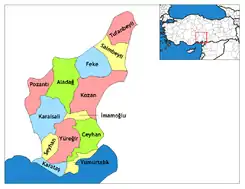Feke
Feke is a municipality and district of Adana Province, Turkey.[2] Its area is 1,218 km2,[3] and its population is 15,833 (2022).[1] It is 122 km from the city of Adana, 620 m above sea-level, a small town on attractive forested mountainside. The current mayor is Ahmet Sel (MHP).
Feke | |
|---|---|
 | |
 Map showing Feke District in Adana Province | |
 Feke Location in Turkey | |
| Coordinates: 37°48′54″N 35°54′45″E | |
| Country | Turkey |
| Province | Adana |
| Government | |
| • Mayor | Ahmet Sel (MHP) |
| Area | 1,218 km2 (470 sq mi) |
| Elevation | 620 m (2,030 ft) |
| Population (2022)[1] | 15,833 |
| • Density | 13/km2 (34/sq mi) |
| Time zone | TRT (UTC+3) |
| Postal code | 01660 |
| Area code | 0322 |
| Website | www |
History
The area was settled by the Hittites in the 16th century BC, the Persians in the 6th century BC, conquered by Alexander the Great in 333 BC, and later passed into the hands of the Romans and Byzantines.
Feke commands a pass across the Taurus mountains directly north of Adana, and a castle was first built in the Byzantine period. The name then was Vahka and has since mutated to today's spelling Feke.
Beginning in the 10th century AD the Byzantine government forcibly settled Armenians into Cilicia to act as guards on the frontier with Syria. With the collapse of Byzantine rule in Asia Minor after the Battle of Manzikert it fell upon the Armenians in Cilicia to defend themselves, and in 1097/98 they managed during the reign of Constantine I to capture this castle and rebuild most of the Greek fortifications. It became an important stronghold for the Rubenid barons, who later became the rulers of the Armenian Kingdom of Cilicia. It was captured by the Mameluks and then the Ottomans.
Below the castle are the imposing remains of a two-story early Byzantine church and a late antique/medieval town.[4]
The impressive circuit walls, towers, and vaulted chambers of the castle are positioned at the top of an elongated mountainous outcrop, primarily flanking the more accessible western side.[5] Sheer cliffs precluded the need for defenses at the east. The outer gatehouse, which consists of a winding staircase and an elaborate bent entrance, leads to the summit. Here there are cisterns, residential quarters, and embrasured loopholes for archers. Most of the exterior masonry is the typical Armenian rusticated ashlar with finely drafted margins.
Composition
There are 48 neighbourhoods in Feke District:[6]
- Akkaya
- Akoluk
- Bağdatlı
- Bahçecik
- Belenköy
- Çandırlar
- Çondu
- Çürükler
- Değirmenciuşağı
- Gaffaruşağı
- Gedikli
- Göbelli
- Gökçeli
- Gürümze
- Güzpınarı
- Hıdıruşağı
- İncirci
- İslam
- Kaleyüzü
- Karacaoğlan
- Karacauşağı
- Kaşaltı
- Kayadibi
- Kazancı
- Keklikçe
- Kırıkuşağı
- Kısacıklı
- Kızılyer
- Koçyazı
- Konakkuran
- Kovukçınar
- Mansurlu
- Musalar
- Olucak
- Ormancık
- Ortaköy
- Oruçlu
- Paşalı
- Şahmuratlı
- Sülemişli
- Süphandere
- Tenkerli
- Tokmanaklı
- Tortulu
- Uğurlubağ
- Yaylapınar
- Yerebakan
- Yeşildüşmüş
References
- "Address-based population registration system (ADNKS) results dated 31 December 2022, Favorite Reports" (XLS). TÜİK. Retrieved 12 July 2023.
- Büyükşehir İlçe Belediyesi, Turkey Civil Administration Departments Inventory. Retrieved 12 July 2023.
- "İl ve İlçe Yüz ölçümleri". General Directorate of Mapping. Retrieved 12 July 2023.
- Edwards, Robert W., “Settlements and Toponymy in Armenian Cilicia,” Revue des Études Arméniennes 24, 1993, pp.203-04.
- Edwards, Robert W. (1987). The Fortifications of Armenian Cilicia: Dumbarton Oaks Studies XXIII. Washington, D.C.: Dumbarton Oaks, Trustees for Harvard University. pp. 259–265, 286, pls.260a-269a. ISBN 0-88402-163-7.
- Mahalle, Turkey Civil Administration Departments Inventory. Retrieved 12 July 2023.
External links
- Municipality website
- District governor website
- Extensive photographic survey, description and plan of Vahga Castle / Feke
